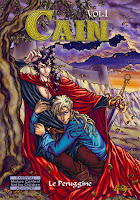 Creator: Moyoco Anno
Creator: Moyoco Anno
U.S. publisher: Tokyopop
ISBN: 9781591821694
Released: April 2003
Original release: 1996
Happy Mania was my introduction to the work of Moyoco Anno. The series was actually one of her earliest professional works and was the first of her manga to be released in English, preceding Flowers & Bees by about half a year. Happy Mania, Volume 1 was first published in Japan in 1996. Tokyopop released the English-language edition in 2003. I believe that Happy Mania was one of Tokyopop’s first shrink-wrapped, mature manga. It was also one of the first, if not the first josei manga—manga intended for an adult female audience—to be released in English. If I recall correctly, Happy Mania was also the first josei manga that I ever read. What I don’t remember is how I learned about Happy Mania or why I picked up the eleven-volume series to begin with. I’m glad that I did, though; it ended up being an unexpected surprise. And I’m happy to give Happy Mania another, closer look for the Moyoco Anno Manga Moveable Feast.
Twenty-four-year old Kayoko Shigeta wants only one thing in her life—a boyfriend. Luckily for her, Shigeta’s love horoscope seems to indicate that the right guy for her is just around the corner. Having been dumped almost a year earlier, she’s not about to let her chance at true love slip her by. In fact, she takes a job at a local book store in order to meet more men, hoping to find her mate for life. But for one reason or another, Shigeta just can’t seem to land a long-term boyfriend. She does have plenty of flings, though. But the men she pursues and attracts simply aren’t interested in a committed relationship. Well, there is Takahashi—Shigeta’s coworker who is genuinely in love with her. But Shigeta isn’t about to give the awkward, geeky Takahashi a second glance. She wants the perfect boyfriend, someone much cooler and better looking. Shigeta just can’t understand what she’s doing wrong. Will she be doomed to be alone forever?
Happy Mania is very aptly named. Shigeta is the most manic character I have ever encountered in a manga. She’s a terrible person—incredibly self-absorbed, judgemental, impulsive, and selfish. But her negative traits (which seem to be most of them) are so exaggerated that Happy Mania ends up being hilarious rather than annoying, assuming that the reader can put up with Shigeta to begin with. (I probably could never be her friend, but I do like her immensely as a character.) In an interview, Anno mentioned that she meant Happy Mania to be in part a cautionary tale. All of Shigeta’s romantic failures are brought upon by herself. It’s difficult to feel sorry for her when she’s flying from one obsessive love to the next or deliberately trying to ruin someone else’s happiness. Takahashi, the poor guy, is an entirely different matter and Shigeta’s complete opposite. He’ much too nice for his own good.
I think Happy Mania works because Shigeta is so outrageously over-the-top. One moment she’s in the depths of despair and in the next she’s caught up in her own delusions. A more realistic portrayal would have ended up being depressing rather than funny. And Happy Mania is very funny, even if it’s not always very kind. Truly horrible things happen to Shigeta and those around her (often as the direct result of her actions.) It’s all very melodramatic, and parts of Happy Mania may at first hardly be believable, but underneath are some very nasty grains of truth. Shigeta’s obsession with finding true love is something that many people can probably identify with, but woe be the person who actually follows her example. The first volume of Happy Mania actually provides some great dating advice—just think of what Shigeta would do in any given situation and then, whatever you do, don’t do it. In real life, Shigeta would be utterly exhausting to have as a friend. Thankfully, Happy Mania isn’t real life and provides a buffer against her mania.











